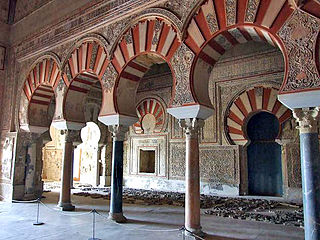Al-Hakam II: Difference between revisions
Jbribeiro1 (talk | contribs) |
→See also: in lede |
||
| Line 40: | Line 40: | ||
==See also== |
==See also== |
||
{{portal|Islam|Spain|LGBT|Biography|History}} |
{{portal|Islam|Spain|LGBT|Biography|History}} |
||
* [[Al-Andalus]] |
|||
* [[Moors]] |
* [[Moors]] |
||
* [[Islam in Spain]] |
* [[Islam in Spain]] |
||
Revision as of 20:58, 7 October 2012
| Al-Hakam II | |
|---|---|
 | |
| Caliph of Córdoba | |
| Reign | 961–976 |
| Predecessor | Abd ar-Rahman III |
| Successor | Hisham II |
| Born | January 13, 915 |
| Died | October 16, 976 (aged c61) |
| Father | Abd ar-Rahman III |
Al-Hakam II (al-Ḥakam II ibn ʿAbd al-Raḥmān III; Arabic: الحكم الثاني ابن عبد الرحمن) (January 13, 915 – October 16, 976) was the second Caliph of Cordoba, in Al-Andalus (Moorish Iberia, which became part of modern Spain), and son of Abd-ar-rahman III (al-Nasir). He ruled from 961 to 976.
Early Rule
Al-Hakam II succeeded to the Caliphate after the death of his father Abd ar-Rahman III in 961. He secured peace with the Christian kingdoms of northern Iberia, and made use of the stability to develop agriculture through the construction of irrigation works. Economic development was also encouraged through the widening of streets and the building of markets.
Patron of Knowledge
Hakam himself was very well versed in numerous sciences. He would have books purchased from Damascus, Baghdad, Constantinople, Cairo, Makkah, Madinah, Kufa, and Basra. His status as a patron of knowledge brought him fame across the Muslim world, to the point where even books written in Iraq, which was under Abbasid control were dedicated to him. During his reign, a massive translation effort was undertaken, and many books were translated from Latin and Greek into Arabic. He formed a joint committee of Arab Muslims and Iberian Mozarab Christians for this task.[1]
His personal library was of enormous proportions. Some accounts speak of him having more than 600,000 books. The catalogue of library books itself was 44 volumes long. Of special importance to Hakam was history, and he himself wrote a history of al-Andalus.[1] Following his death, al-Mansur had all "ancient science" books destroyed.[2]
As well, the famous physician, scientist, and surgeon Abu al-Qasim al-Zahrawi (Abulcasis) was active in Al-Hakam's court during his reign.
Construction Projects

His building works included an expansion of the main mosque of Cordoba (962–966), the Mezquita, and the completion of the Royal residence Medina Azahara (976), which Abd ar-Rahman III had begun in 936.
Military Conflict in North Africa
Whilst the internal administration was left increasingly to the Berber Vizir Al-Mushafi, General Ghalib was gradually gaining influence as leader of the army. He was chiefly pre-occupied with repulsing the last Norman attacks (966, 971), and with the struggle against the Zirids and the Fatimids in northern Morocco. The Fatimids were defeated in Morocco in 974, while Al-Hakam II was able to maintain the supremacy of the Caliphate over the Christian states of Navarre, Castile and Leon.
Personal Life
In his youth his loves seem to have been entirely homosexual.[3] He was known to have openly kept a male harem.[4] This exclusivity was a problem, since it was essential to produce an heir. A resolution was reached[5] by his taking a concubine, Subh (Sobeya), who dressed in boys' clothes and was given the masculine name of Jafar.
Death and Succession
He was succeeded by his son, Hisham II al-Mu'ayad, who was 11 years old at the time and was a nominal ruler under the Hajib (Grand Vizier) al-Mansur Ibn Abi Aamir.
See also
References
- ^ a b Najeebabadi, Akbar (2001). The History of Islam V.3. Riyadh: Darussalam. p. 145. ISBN 996089293.
{{cite book}}: Check|isbn=value: length (help) - ^ Ann Christy, Christians in Al-Andalus:711-1000, (Curzon Press, 2002), 142.
- ^ Louis Crompton, Homosexuality and Civilisation, Harvard, 1990
- ^ Homosexuality, Daniel Eisenberg, Encyclopedia of Medieval Iberia, ed. Michael Gerli (New York: Routledge, 2003), 398–399.
- ^ Évariste Lévi-Provençal, Histoire de l'Espagne musulmane, Paris, 1950

